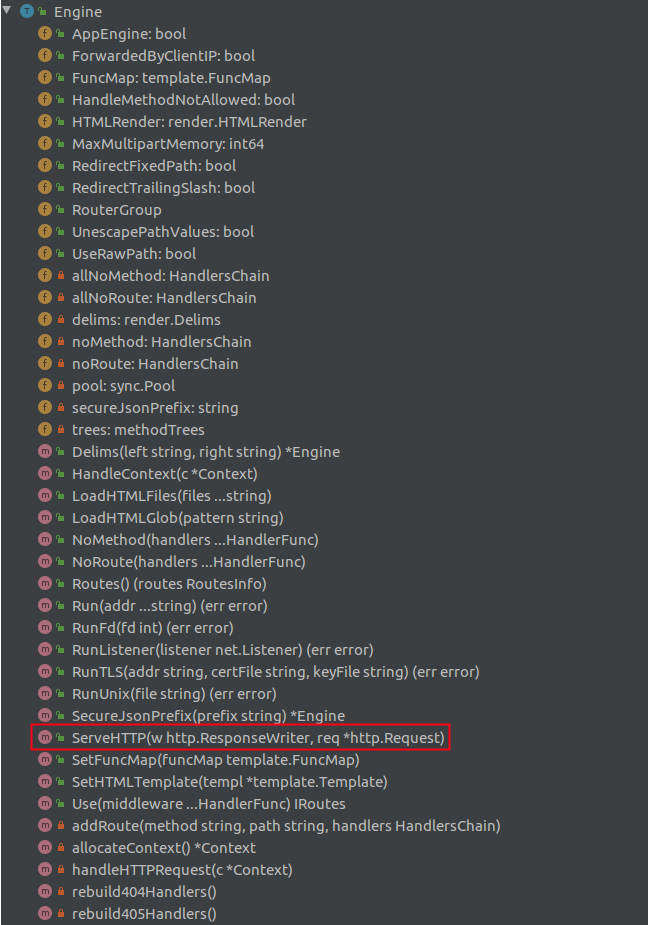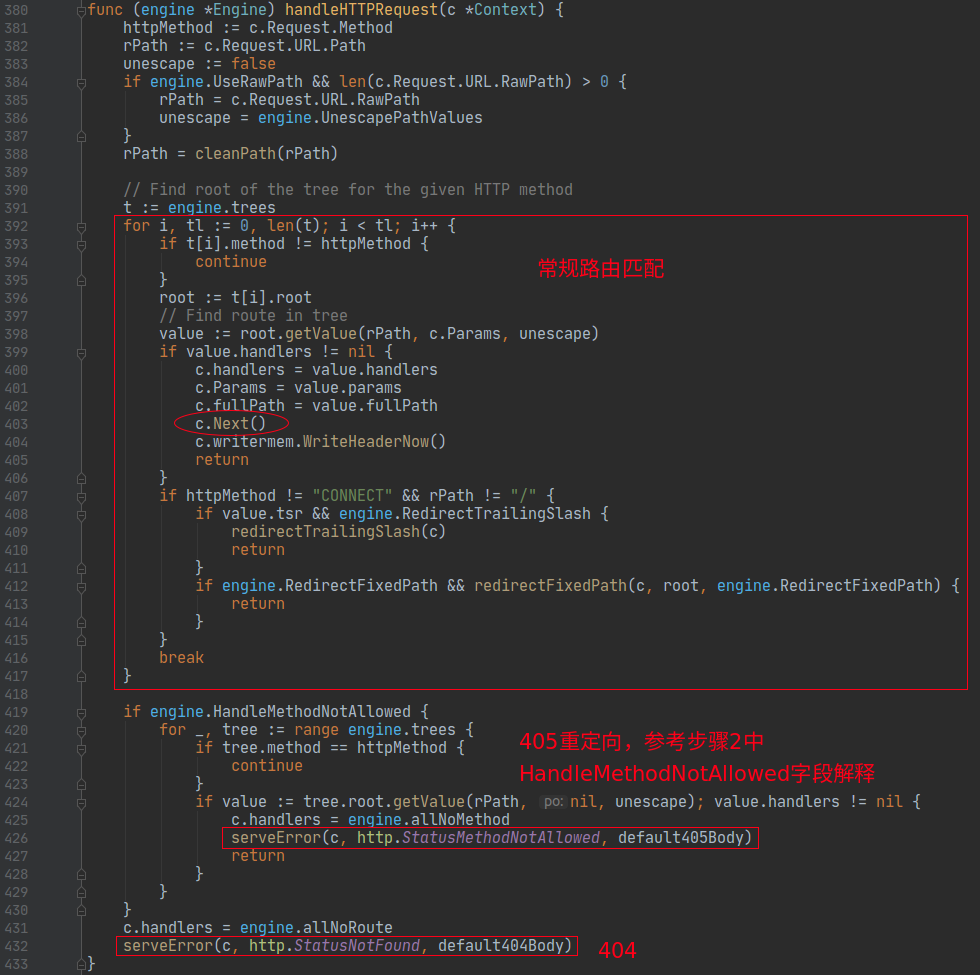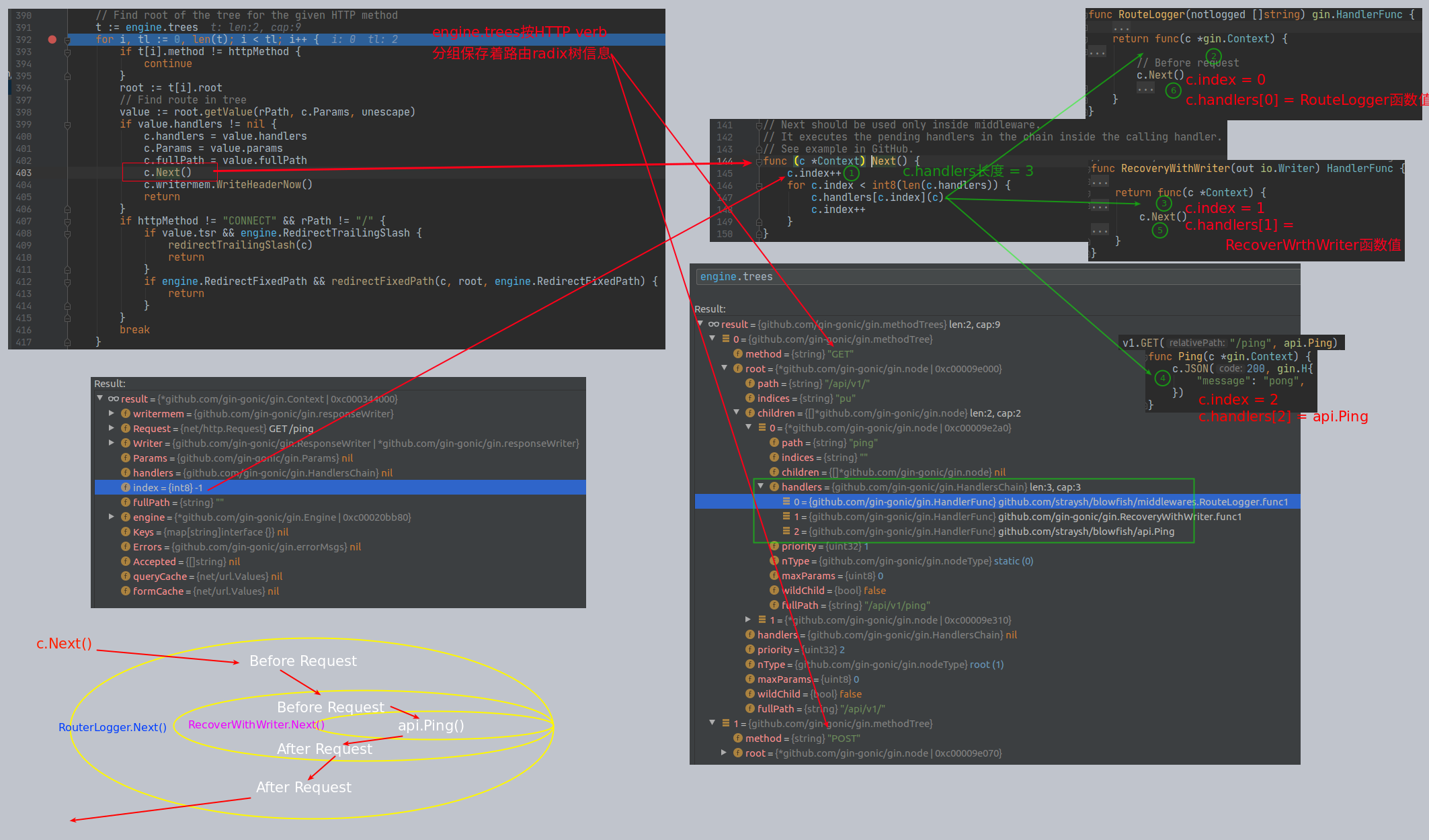持续整理中,不适合阅读
GIN版本 commithash a71af9c144f9579f6dbe945341c1df37aaf09c0d Gin框架的特点
快:路由使用radix trie实现,检索路径短。无反射。API性能可预测。
支持中间件:请求可以有多个中间件逐个处理,最后交给业务处理。例如:Logger,Authorization,GZIP,最后写入数据库。
若发生了panic,Gin可以捕获并恢复错误,因此服务并不会终止,且可有机会介入错误恢复的过程。
JSON校验:Gin可以解析并校验请求的json数据,例如检查字段值。
路由分组:更好的组织路由。通过分组将需要鉴权和不需鉴权的路由分开,分组可以无限嵌套且不影响性能。
错误管理:Gin可以和很方便的收集错误信息。最后使用中间件将错误写入文件或数据库或发送到网络上。
内置视图渲染:提供了易用的接口来渲染JSON,XML和HTML。
可扩展:自定义中间件非常容易。
源代码阅读 服务启动 Socket Server VS HTTP Server HTTP是应用层协议 ;Socket是系统提供的抽象接口,它直接操作传输层协议(如TCP、UDP等)来工作。它们不是一个层级上的概念。建立TCP连接 🡺 客户端发送报文 🡺 服务器相应报文 🡺 客户端或服务器关闭连接。每一个请求都要重复这个过程。虽说TCP协议是长连接的,但上层的HTTP协议会主动关闭它。Connection: keep-alive头信息,来重用连接,减少创建连接的消耗。它受到重用次数和超时时间的限制(服务器设置),触发限制时仍会主动断开连接。因此这个所谓的”长连接”和Socket长连接的本质是不同的。
Socket Server例子,内层的for循环读并不会主动关闭连接(不发生panic时)
1 2 3 4 5 6 7 8 9 10 11 12 13 14 15 16 17 18 19 20 21 22 23 24 25 26 27 28 29 30 func main () "tcp" , ":8080" ) if err != nil {panic (err)defer srv.Close()for {if err != nil {"accept failed:" , err.Error())continue go func (c net.Conn) defer c.Close()make ([]byte , 1024 )for {if err != nil {"read failed:" , err.Error())continue "received data=" , receiveData)
HTTP Server
1 2 3 4 5 6 7 8 9 10 11 12 13 14 15 type handler struct {func (h handler) "request uri=%s\n" , requestUrl)byte (msg))func main () "127.0.0.1:8080" , handler{}) if err != nil {panic (err)
HTTP Server的底层还是TCP连接,对比上面Socket Server的代码,我们期望在HTTP Server的实现里发现
创建连接net.Listen
网络监听srv.Accept()
读取数据c.Read(buf)
额外的,在服务端发送完数据后,应该要关闭连接
带着以上四个目标,我们来跟一下HTTP Server的启动过程。
启动HTTP Servererr := http.ListenAndServe("127.0.0.1:8080", handler{})
构造server对象
1 2 3 4 func ListenAndServe (addr string , handler Handler) error {return server.ListenAndServe()
调用server的ListenAndServe方法。在#Line9我们发现了net.Listen("tcp", addr),目标1找到 。
1 2 3 4 5 6 7 8 9 10 11 12 13 14 func (srv *Server) error {if srv.shuttingDown() {return ErrServerClosedif addr == "" {":http" "tcp" , addr)if err != nil {return errreturn srv.Serve(ln)
跟入#Line13行代码srv.Serve(ln) 。这里,#Line4:rw,err := l.Accept(),目标2找到 。rw即是net.Conn,在#Line14重新包装了rw ,,并在#Line14启动协程go c.serve(connCtx)。
1 2 3 4 5 6 7 8 9 10 11 12 13 14 15 16 17 18 func (srv *Server) error {for {if cc := srv.ConnContext; cc != nil {if connCtx == nil {panic ("ConnContext returned nil" )0 go c.serve(connCtx)
继续挖go c.serve(connCtx)看看net/http是如何处理一个Request的。先快速扫一下这个函数里面做了哪些事情:
#Line20w, err := c.readRequest(ctx)构建Response对象。向内追找到HTTP协议的解析过程newTextprotoReader。目标3找到 。
#Line35serverHandler{c.server}.ServeHTTP(w, w.req) 处理业务逻辑(即用户定义的路由逻辑)。ServeHTTP的第一个参数w就是Response对象,负责向客户端响应数据,w.req即Request,负责解析请求参数、头信息等。
#Line40w.finishRequest()中有flush操作,到这里服务器已经完成了数据响应。
#Line50-64处理了keep-alive重用连接和idle_timeout空闲超时断开连接的逻辑。这里涉及到一些网络知识不具体展开。Connection: close或者服务器保持连接直到空闲超时,都会return从而执行#Line5中的defer代码,注意源代码中的#Line1775~1777 。目标4找到
需要额外关注一下#Line35行上面的注释 。这里明确指出了net/http没有实现pipeline,理由是在HTTP1.1中pipeline并没有被(客户端/浏览器)广泛的实现,因此扔到了和HTTP2.0一起实现。
1 2 3 4 5 6 7 8 9 10 11 12 13 14 15 16 17 18 19 20 21 22 23 24 25 26 27 28 29 30 31 32 33 34 35 36 37 38 39 40 41 42 43 44 45 46 47 48 49 50 51 52 53 54 55 56 57 58 59 60 61 62 63 64 65 66 func (c *conn) defer func () defer cancelCtx()4 <<10 )for {if c.r.remain != c.server.initialReadLimitSize() {if err != nil {...}if req.expectsContinue() {...}if requestBodyRemains(req.Body) {...}if c.hijacked() {return if !w.shouldReuseConnection() {if w.requestBodyLimitHit || w.closedRequestBodyEarly() {return nil ))if !w.conn.server.doKeepAlives() {return if d := c.server.idleTimeout(); d != 0 {if _, err := c.bufr.Peek(4 ); err != nil {return
P.S. 这里再额外挖一下#Line35serverHandler{c.server}.ServeHTTP(w, w.req)的实现,将用户代码和net/http包打通。ServeHTTP方法。 sh.srv.Handler.ServeHTTP(rw, req),这里的srv就是本文步骤2中构造server对象的这个server对象。.Handler.ServeHTTP最终调用的是我们的HTTP Serverdemo中#Line4-9的代码。
Gin的启动过程 挖完了net/http包,对http网络请求的过程有了一个整体的认知,接下来正式开挖Gin。
启动服务非常简便engine := gin.New()然后engine.Run(":8080")
1 2 3 4 5 6 7 8 9 func main () ":8080" )
gin.New()的细节。其中Engine的结构
RedirectTrailingSlash若请求地址是/foo/且未匹配,但/foo可以匹配,则将客户端重定向到/foo,若请求是GET则状态码是301,其他动词则是307RedirectFixedPath未匹配时尝试去除多余的../或//以修正路径(且转化为小写),例如/FOO或/..//FOO都能匹配/fooHandleMethodNotAllowed未匹配时尝试其他动词,若路由匹配则以状态码405响应,否则将请求代理到NotFound句柄。
1 2 3 4 5 6 7 8 9 10 11 12 13 14 15 16 17 18 19 20 21 22 23 24 25 26 27 28 29 30 31 32 33 34 35 func New () nil ,"/" ,true ,true ,false ,false ,true ,false ,true ,make (methodTrees, 0 , 9 ),"{{" , Right: "}}" },"while(1);" ,func () interface {} { return engine.allocateContext()return engine
engine.Run(":8080")中的细节。它仅仅是http.ListenAndServe(address, engine)的语法糖,啥也没做。net/http包。其核心代码全部在Engine这个结构体中。根据我们分析net/http包的经验,Engine中一定实现了ServeHTTP方法
1 2 3 4 5 6 7 8 9 10 11 func (engine *Engine) string ) (err error ) {defer func () "Listening and serving HTTP on %s\n" , address)return
engine.ServeHTTP到底干了啥? Engine结构体的方法集:
gin.Context
1 2 3 4 5 6 7 8 9 10 11 12 13 func (engine *Engine)
engine.handleHTTPRequest(c)的细节。
可以看到源码#Line403行调用c.Next()后c.index从-1自增到0,然后调用c.handlers[0]句柄,执行第一个中间件RouteLogger,而在中间件中我们需要再次调用c.Next()。非常明显的一个递归调用,然后执行第二个中间件RecoverWithWriter,之后调用GET动词注册的路由api.Ping,最后调用链路依次返回。
路由 Gin的路由按HTTP动词,分9组(默认engine.trees = make(methodTrees, 0, 9))分别对应GET组,POST组,PUT组等。methodTrees是[]methodTree的别名:type methodTrees []methodTree。node是一颗前缀树或Radix trie。
1 2 3 4 type methodTree struct {string
Trietrie译为字典树或单词查找树或前缀树。这是一种搜索树——存储动态集合或关联数组的有序的树形数据结构,且通常使用字符串做键。与二叉搜索树不同,其节点上并不直接存键。其在树中的位置决定了与其关联的键。所有的子节点都有相同的前缀,而根节点对应的是空字符串。键只与叶子节点关联。
trie术语的发明者念/ˈtriː/(tree),而有些作者念为/ˈtraɪ/以便和tree区别。
下图是一颗字典树,描述了键值为A、to、tea、ted、ten、i、in、inn的情况。(图中节点并不是完全有序的,虽然应该如此:如root节点与t节点)
不难想象,字典树典型的应用场景是单词计数。
trie通常用来取代hash table,因为有如下优势:
在最坏的情况下,trie的时间复杂度是O(m),其中m是字符串的长度。但哈希表有key碰撞的情况,最坏的情况下其复杂度是O(N),虽然通常是O(1),且计算哈希的复杂度是O(m)。
trie中没有碰撞。当trie中一个key对应多个值时,会使用buckets来存储多个值,与哈希表中发生碰撞时使用的桶相似。
不论有多少个key,都不需哈希函数或重哈希函数。
key的路径是有序的。
但同时,相对哈希表,trie有如下缺点:
trie的搜索通常比哈希表慢,特别是需要从硬盘上加载数据时。浮点数做key通常导致链路过长。
有些trie可能比哈希表需要更多的空间,因为每一个字符都要分配内存。而哈希表只需要申请一块内存。
Radix Treeradix tree也叫radix trie或compact prefix trie。在字典树中,每一个字符都要占一个节点,这样造成树过高。radix trie则将唯一的子节点压缩到自身来降低树的高度。
参考资料:
字典树 Radix树 Trie Data Structure Tutorial - Introduction to the Trie Data Structure Trie and Patricia Trie Overview 图解Redis中的Radix树 Linux 内核数据结构:Radix树
解析请求参数 渲染JSON session & cookie URL重定向 goroutin inside a middleware 日志模块 debug日志 /debug.go#L55
1 2 3 4 5 6 7 8 9 10 11 func debugPrint (format string , values ...interface {}) if IsDebugging() {if !strings.HasSuffix(format, "\n" ) {"\n" "[GIN-debug] " +format, values...)
/debug.go#L97
1 2 3 4 5 6 7 8 func debugPrintError (err error ) if err != nil {if IsDebugging() {"[GIN-debug] [ERROR] %v\n" , err)
路由日志 /logger.go#L131
1 2 3 4 5 6 7 8 9 10 11 12 13 14 15 16 17 18 19 20 21 22 23 24 25 26 var defaultLogFormatter = func (param LogFormatterParams) string {var statusColor, methodColor, resetColor string if param.IsOutpu123456if param.Latency > time.Minute {return fmt.Sprintf("[GIN] %v |%s %3d %s| %13v | %15s |%s %-7s %s %#v\n%s" ,"2006/01/02 - 15:04:05" ),
/logger.go#L203
1 2 3 4 5 6 7 8 9 10 11 12 13 14 15 16 17 18 19 20 21 22 23 24 25 26 27 28 29 30 31 32 33 34 35 36 37 38 39 40 41 42 43 44 45 46 47 48 49 50 51 52 53 54 55 56 57 58 59 60 61 62 63 64 65 66 67 68 69 func LoggerWithConfig (conf LoggerConfig) if formatter == nil {if out == nil {true if w, ok := out.(*os.File); !ok || os.Getenv("TERM" ) == "dumb" ||false var skip map [string ]struct {}if length := len (notlogged); length > 0 {make (map [string ]struct {}, length)for _, path := range notlogged {struct {}{}return func (c *Context) if _, ok := skip[path]; !ok {if raw != "" {"?" + raw
Build a single binary with templates See a complete example in the https://github.com/gin-gonic/examples/tree/master/assets-in-binary directory.
http2 server push https on port 8080
go服务要不要配nginx前端 参考阅读:
Gin的路由为什么这么快?
参考资料:





